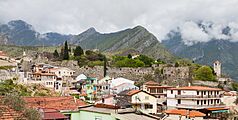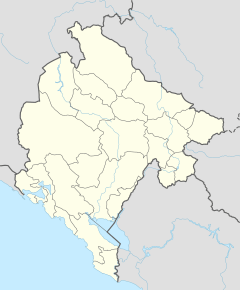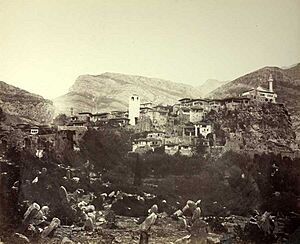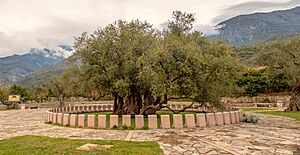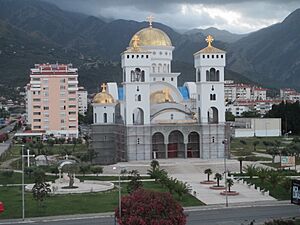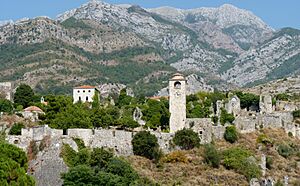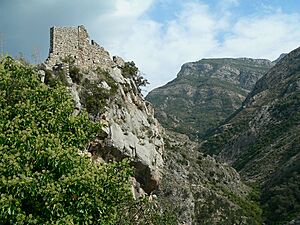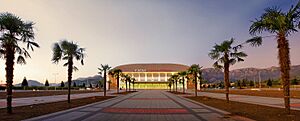Bar, Montenegro facts for kids
Quick facts for kids
Bar, Montenegro
Бар
Tivari |
|||
|---|---|---|---|
|
City and municipality
|
|||
|
From the top, Stari Bar, Church of St. Jovan Vladimir, The Port of Bar
|
|||
|
|||
| Country | |||
| Municipality | |||
| Settlements | 85 | ||
| Area | |||
| • City and municipality | 598 km2 (231 sq mi) | ||
| Population
(2023 census)
|
|||
| • Rank | 3rd in Montenegro | ||
| • Density | 67.0/km2 (174/sq mi) | ||
| • Urban | 15,868 |
||
| • Rural | 30,303 |
||
| • Municipality | 46,171 |
||
| Demonym(s) | Barani | ||
| Time zone | UTC+1 (CET) | ||
| • Summer (DST) | UTC+2 (CEST) | ||
| Postal code |
85000
|
||
| Area code | +382 30 | ||
| ISO 3166-2 code | ME-02 | ||
| Car plates | BR | ||
| Climate | Csa, Cfa | ||
Bar is a town and seaport located on the coast of Montenegro. It is the main city of the Bar Municipality and a popular spot for tourists. In 2023, the city itself had about 15,868 people, while the whole Bar Municipality had a total population of 46,171.
Contents
What's in a Name?
The name Bar is believed to be a shorter version of Antivari. This name likely comes from the Latin word Antibarum or Antibari. It means "opposite Bari" because the city is located across the Adriatic Sea from Bari in Italy. Over time, the name changed in different languages. For example, in Italian it was Antivari, and in Albanian it is Tivari.
A Look Back in Time: Bar's History
Ancient Beginnings
Bar is a very old city. We don't know exactly when it was founded, but archaeologists have found many signs of life from prehistoric times. These findings date back to the Neolithic era, which was a very long time ago! Some believe Bar was first mentioned in the 6th century as a rebuilt Roman castle called Antipargal. The name Antibarium first appeared in the 10th century.
The Middle Ages
In the 6th and 7th centuries, Slavs settled in the Balkans. A Slavic state called Duklja was first mentioned in the 10th century. Jovan Vladimir, who ruled from 1000 to 1016, was an early known ruler of Duklja.
Later, Stefan Vojislav (who ruled from 1018 to 1043) defeated the Byzantine army in a battle near Bar. He then made Bar his main city. His son, Mihailo I of Duklja, continued to fight the Byzantines to keep the town independent. This led to a group of states known as the Serbian Grand Principality.
Bar was ruled by different groups over the centuries. From 1101 to 1166, the Vukanović dynasty was in charge. Then, from 1166 to 1183, the Byzantines took over. In 1183, Stefan Nemanja conquered Bar. It was then ruled by the Nemanjić dynasty until 1360. After that, the Balšić noble family took control, and Queen Jelena and Balša III made Bar their capital.
Venetian and Ottoman Rule
Between 1405 and 1412, the Venetians controlled Bar. This was a time of great growth for the city. The Venetians gave the people of Bar special rights, allowing Bar to become a city-state. The people of Bar had their own laws, managed their own defense, had their own courts, and even printed their own money!
After the Venetians, the Balšićs ruled again. Other rulers like Stefan Lazarević and Đurađ Branković also controlled Bar in the early 15th century.
From 1443 to 1571, the Venetians ruled Bar again, calling it Antivari. It was a town with its own coat of arms, flag, laws, and mint. In 1571, the Ottomans took over Antivari and kept control until 1878. During this time, the Archdiocese of Bar (a Catholic church region) faced challenges. Some local people moved away, and new groups arrived, changing the religious makeup of the area.
In 1878, the Ottomans gave Antivari to Montenegro after losing a war. Montenegro's main goal was to expand its territory. After discussions, it was agreed that Bar would become part of Montenegro. The port of Bar was made neutral, meaning it couldn't be used for military purposes by Montenegro.
In 1885, the castle of King Nikola was built. He built it for his daughter Princess Zorka. The castle complex included a chapel, watchtower, and beautiful gardens. Today, this former castle is the Bar Heritage Museum, where cultural events are held.
Modern Times
After Montenegro took control of Bar, the city was rebuilt. A new urban area, called Pristan (Novi Bar), started to form in the early 20th century.
Guglielmo Marconi, an Italian scientist, made the first radio connection between Antivari (Bar) and Bari in Italy on August 30, 1904. In 1908, the first railway in this part of the Balkans began operating in Bar.
During World War I, Bar's port and wireless station were attacked by Austro-Hungarian ships. In August 1914, a large French fleet sank an Austro-Hungarian ship near Bar in the Battle of Antivari. Later, Austro-Hungarian ships continued to bombard the port, causing damage and destroying supplies.
In 1918, Bar became part of the Kingdom of Serbs, Croats and Slovenes.
In 1976, the old Pristan area was removed to make way for the expansion of the Port of Bar. Many people moved to Topolica, where King Nikola's Castle was located.
After a big earthquake in 1979, Bar grew rapidly. Until 1990, Bar was a very important port for SFR Yugoslavia. It became a major center for politics, industry, tourism, and sports. This growth was helped by new roads connecting Bar to other cities, like the Bar-Belgrade railway opened in 1976.
Where is Bar?
Location, Location, Location
Bar is located on the western coast of Montenegro, right on the Adriatic Sea. It's about 53 kilometers (33 miles) from Podgorica, the capital of Montenegro. To the east of Bar is Lake Skadar, the largest lake in South Europe. Across the sea to the west is Italy.
Bar's Climate
Bar has a mix of humid subtropical and Mediterranean climate. This means it has cool, rainy winters and warmer, drier, and sunnier summers. Snow is very rare in Bar, usually happening only once every few years. The highest snowfall recorded was 9 cm (3.5 inches) in January 2000.
In summer, temperatures are usually around 27 to 28°C (81 to 82°F). Even in summer, there can be some rain, but it's not common. Spring and fall are mild, but the weather can be a bit unpredictable. Bar gets a lot of sunshine, with about 2523 hours per year!
| Climate data for Bar (1991–2020 normals, extremes 1949–present) | |||||||||||||
|---|---|---|---|---|---|---|---|---|---|---|---|---|---|
| Month | Jan | Feb | Mar | Apr | May | Jun | Jul | Aug | Sep | Oct | Nov | Dec | Year |
| Record high °C (°F) | 21.2 (70.2) |
27.2 (81.0) |
26.0 (78.8) |
30.7 (87.3) |
32.5 (90.5) |
36.6 (97.9) |
37.7 (99.9) |
37.0 (98.6) |
35.5 (95.9) |
32.3 (90.1) |
28.4 (83.1) |
22.6 (72.7) |
37.7 (99.9) |
| Mean daily maximum °C (°F) | 13.2 (55.8) |
13.7 (56.7) |
15.9 (60.6) |
19.0 (66.2) |
23.6 (74.5) |
27.6 (81.7) |
30.1 (86.2) |
30.4 (86.7) |
27.0 (80.6) |
23.0 (73.4) |
18.6 (65.5) |
14.4 (57.9) |
21.4 (70.5) |
| Mean daily minimum °C (°F) | 5.5 (41.9) |
5.9 (42.6) |
7.8 (46.0) |
10.5 (50.9) |
14.5 (58.1) |
18.4 (65.1) |
20.6 (69.1) |
21.0 (69.8) |
17.7 (63.9) |
14.1 (57.4) |
10.5 (50.9) |
7.0 (44.6) |
12.8 (55.0) |
| Record low °C (°F) | −7.2 (19.0) |
−6 (21) |
−5.5 (22.1) |
0.7 (33.3) |
4.7 (40.5) |
9.1 (48.4) |
12.2 (54.0) |
9.5 (49.1) |
7.9 (46.2) |
−0.2 (31.6) |
−2.4 (27.7) |
−5.6 (21.9) |
−7.2 (19.0) |
| Average precipitation mm (inches) | 142.1 (5.59) |
128.2 (5.05) |
130.7 (5.15) |
111.9 (4.41) |
81.5 (3.21) |
53.6 (2.11) |
32.0 (1.26) |
45.3 (1.78) |
134.0 (5.28) |
152.3 (6.00) |
164.6 (6.48) |
178.9 (7.04) |
1,355.1 (53.35) |
| Average precipitation days (≥ 1 mm) | 9.6 | 9.8 | 9.0 | 9.1 | 6.9 | 4.4 | 2.8 | 3.2 | 6.4 | 9.2 | 10.4 | 11.5 | 92.3 |
| Average relative humidity (%) | 65 | 64 | 67 | 71 | 73 | 72 | 68 | 69 | 70 | 68 | 69 | 68 | 69 |
| Mean monthly sunshine hours | 120.9 | 124.2 | 170.9 | 198.9 | 259.7 | 297.4 | 351.5 | 317.3 | 252.1 | 198.8 | 124.6 | 111.6 | 2,527.9 |
| Source 1: National Oceanic and Atmospheric Administration | |||||||||||||
| Source 2: Hydrological and Meteorological Service of Montenegro (humidity, sun 1961–1990) | |||||||||||||
Plants and Animals
The coastal area around Bar has many types of shrubs and trees like oak, laurel, and myrtle. Further north in the mountains, you can find oak and beech forests.
Bar is also known for its fruit trees. You'll see tangerine, orange, lemon, pomegranate, olive, and fig trees growing here. There's even a special Ginkgo biloba tree in King Nikola's palace park.
Skadar Lake is home to many birds, including pelicans. In the mountains around Bar, you might find animals like rabbits, foxes, wolves, and boars. The sea near Bar has various shells, snails, and crabs.
Who Lives in Bar?
| Historical population | ||
|---|---|---|
| Year | Pop. | ±% |
| 1948 | 897 | — |
| 1953 | 1,113 | +24.1% |
| 1961 | 2,184 | +96.2% |
| 1971 | 3,612 | +65.4% |
| 1981 | 6,742 | +86.7% |
| 1991 | 10,971 | +62.7% |
| 2003 | 13,719 | +25.0% |
| 2011 | 13,503 | −1.6% |
| 2023 | 15,868 | +17.5% |
Bar is the main city of the Bar Municipality, which includes the town of Sutomore and other smaller coastal towns. In 2023, the Bar Municipality had 46,171 people, with 15,868 living in Bar city itself.
Different Communities
The Bar Municipality is divided into 12 communes, which include 83 settlements. Some of these are Šušanj, Sutomore, and Stari Bar (Old Bar).
Ethnic Groups
Here's a look at the different ethnic groups in Bar in 2011:
| Ethnicity | Number | Percentage |
|---|---|---|
| Montenegrins | 6,901 | 51.11% |
| Serbs | 4,487 | 33.23% |
| Bosniaks | 410 | 3.04% |
| Ethnic Muslims | 273 | 2.02% |
| Albanians | 121 | 0.89% |
| Croats | 121 | 0.89% |
| Other | 78 | 0.58% |
| Not declared | 787 | 5.82% |
| Total | 13,503 | 100% |
Religions in Bar
The main religion in Bar is Orthodox Christianity. However, you can find churches for both Eastern Orthodox and Catholic Christians, as well as mosques built by the Ottomans for Islamic worship. Bar is also known as the birthplace of Saint Jovan Vladimir. In 1089, the Roman Catholic Archdiocese of Bar was founded.
| Religion | Number | Percentage |
|---|---|---|
| Eastern Orthodox | 10,499 | 77.7% |
| Islam | 1,433 | 10.6% |
| Roman Catholic | 745 | 5.5% |
| Atheist | 250 | 1.85% |
| Agnostic | 19 | 0.14% |
| Other | 59 | 0.4% |
| Undeclared | 459 | 3.3% |
Bar's Economy
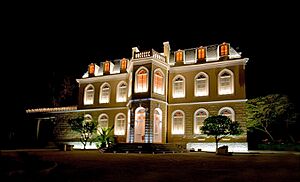
Bar's economy mainly depends on the Port of Bar, the Belgrade–Bar railway, and the Sozina tunnel. The Port of Bar is a very important part of the city. It covers a large area and can handle 5 million tons of goods each year. The Belgrade–Bar railway, opened in 1976, made it easier for tourists to reach the coast and for goods to be transported to the port.
The food company Primorka has been in Bar for over 50 years. It produces olive oil and pomegranate juice. The area around Bar has many olive trees (about 95,000!) and citrus trees like lemon, orange, tangerine, and grapefruit. The center for subtropical cultures, founded in 1937, is the oldest scientific place in Montenegro. Tourism is also a big part of Bar's economy.
Getting Around: Transport
Bar has a ferry service to Bari, Italy, run by Montenegro Lines. During peak season, ferries also go to Ancona, Italy. Bar is well connected to other parts of Montenegro and its coast. The Sozina tunnel, finished in 2006, made the drive to Podgorica much shorter, about 50 km (31 miles).
The Adriatic motorway connects Bar to other coastal towns like Ulcinj and Herceg Novi. Bar is also the last stop on the Belgrade–Bar railway, which links Bar to Podgorica, northern Montenegro, and Serbia. Podgorica Airport is about 40 km (25 miles) from Bar, with regular flights to many European cities. There are also public and intercity bus services.
Sports in Bar
Bar has more than fifty sports clubs and groups, including a chess club. The city's main football (soccer) club is FK Mornar. They play at Stadion Topolica along with other local teams. KK Mornar Bar is the local basketball club.
Many hotels and schools in Bar have sports facilities. The main sports center in town is the Sports and Recreation Centre. Water sports like diving are popular. Because Bar is so close to the sea and a lake, it's a great place for sports tourism. Bar has even hosted big sports events, like the 2010 FIBA Europe Under-16 Championship for basketball.
Notable People
International Friends
Twin Towns and Sister Cities
Bar is twinned with many cities around the world, which means they have special friendly relationships.
 Adana, Turkey
Adana, Turkey Bari, Italy
Bari, Italy Bor, Serbia
Bor, Serbia Bornova, Turkey
Bornova, Turkey Cherepovets, Russia
Cherepovets, Russia Corfu, Greece
Corfu, Greece Elbasan, Albania
Elbasan, Albania Hongkou (Shanghai), China
Hongkou (Shanghai), China Küçükkuyu, Turkey
Küçükkuyu, Turkey Kula, Serbia
Kula, Serbia Kursk, Russia
Kursk, Russia Kragujevac, Serbia
Kragujevac, Serbia Mali Iđoš, Serbia
Mali Iđoš, Serbia Maribor, Slovenia
Maribor, Slovenia Mariupol, Ukraine
Mariupol, Ukraine Ningbo, China
Ningbo, China Nuremberg, Germany
Nuremberg, Germany Piaseczno, Poland
Piaseczno, Poland Podolsk, Russia
Podolsk, Russia Požarevac, Serbia
Požarevac, Serbia Resen, North Macedonia
Resen, North Macedonia Vodnjan, Croatia
Vodnjan, Croatia Živinice, Bosnia and Herzegovina
Živinice, Bosnia and Herzegovina
See also
 In Spanish: Bar (Montenegro) para niños
In Spanish: Bar (Montenegro) para niños


